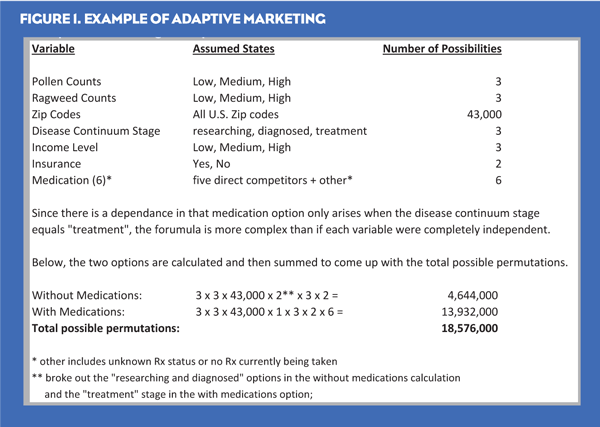Imagine combining a number of marketing and targeting techniques, such as data-driven targeting and personalization, to deliver a unique message to an individual based on what you know about that individual and their current stage of product or disease-state engagement. This is adaptive marketing—and it is the realization of the long promised
one-to-one marketing.
Using many features such as interest-based retargeting, dynamic creative, and unique and custom offers—including differing coupon values on a given creative—adaptive marketing offers various opportunities for marketers, especially those in pharmaceuticals, who are focused on healthcare outcomes, not just on awareness, branding and trial. By definition, adaptive marketing communicates a different message to different people based on where their experience falls on the product or lifecycle phase or disease continuum, and based on their prior engagements with your brand, the disease state or educational materials. This dynamic creative offers unique opportunities to improve outcomes with the appropriate delivery of well-timed relevant messages.
How it Works
The fictional example of adaptive marketing for a seasonal allergy brand in Figure 1, illustrates its complex challenges and benefits.
You are going to target different messages to different patient populations based on several dynamic variables. The variables you choose to target include: Current pollen and ragweed levels (high, medium or low), geographic area such as zip code where we will message uniquely with something like “the Newtown, PA areas are on high alert for pollen counts,” and the patient’s stage on the disease continuum.
For this example, we’ll assume a simple continuum of a patient researching symptoms, recently diagnosed or being treated. In the case of treatment, if we can reasonably determine it, we’ll add a comparative products variable based on medication currently taken. Between antihistamines, decongestants, corticosteroids and eye drops, dozens of drugs are available, but we consider five to be direct competition—and “other,” which includes unknown or no prescription. Finally, we are also going to message based on income levels (low, medium and high) and insurance coverage (y/n). We have many variables here and a lot of possible permutations of audience segments and messaging within a given audience segment.
Two Messaging Examples
Someone might live in a high pollen count zip code, for example, who is being treated with Zyrtec and paying a $10 co-pay with BCBS insurance. Or someone may be in a low pollen count zip code, recently diagnosed with seasonal allergies, but has yet to take a prescription—that person may have no insurance and can’t afford the prescription.
The message to the first patient might read: “The Providence, RI area is on high alert for pollen counts and medium for ragweed. Click here to see why Brand X is more effective than Zyrtec and receive an offer from Brand X covering your first 30 days of co-pay.”
The message to the second might read, “While pollen counts are low in Sacramento, CA, ragweed is on high alert. Did you know both could affect your seasonal allergies? Click here for a special offer from Brand X. No insurance? No problem.”
The permutations of messaging in this example are numerous. In fact, there are 18,576,000 permutations based on these assumptions (see table for calculation). Since an estimated 50 million seasonal allergy sufferers live in the U.S., our average cohort is only 2.7 people. It’s likely that many of our cohorts will have zero people in them, but we won’t know which until we run our campaign. It takes a relatively small number of variables in our equation to create an enormous number of permutations or possible dynamic creative or targeting scenarios.
While an adaptive marketing campaign can be delivered in any medium, the dynamic aspects of the digital channel make it the most ideal and cost-effective channel. Perhaps the best channel for adaptive marketing, though, is personal selling. Real people incorporate adaptive marketing into each engagement as a good sales person adjusts accordingly, in real time, based on customer cues and understanding—but even reps have to stay on label with their communications and can only take it so far. If you had to send reps out to deliver over 18 million messages to patients however, it would not be cost effective.
The Challenges
Let’s examine the complex challenges of creating such a campaign. While improving, most pharma companies’ medical, legal and regulatory groups are simply not built to approve a theoretical template, which is the only way a program with over 18 million possible message permutations could be presented. Much like the title of this article, the messaging will have dynamic aspects that will be modified based on variables that could change.
All possible permutations must be considered, and all possible outcomes for each variable must be listed out. The list of variables and the theoretical templates can then each be approved individually, realizing that any variable may be matched up with any other within the same template structure.
Part of the challenge that regulatory faces: The laws and guidelines we operate under are not keeping up with the pace of change in our industry. Whether they are the broad laws of HIPAA, which protect patient privacy, or the self-imposed NAI guidelines around interest-based targeting, our “rules” are out of date. As we attempt to adjust to market forces and pivot into more outcomes-driven healthcare organizations, HIPAA impedes our industry’s ability to make that conversion. It’s hard to focus on outcomes, much less get paid based on outcomes, without the feedback loop of patient data. Thanks to HIPAA, and other well-intended regulations designed to protect patient privacy, we are driving blindfolded with respect to improving outcomes.
The NAI guidelines regarding interest-based targeting have never been adequate. They’ve left most disease states up to interpretation as to their acceptability for interest-based targeting, failing to differentiate between disease states considered to be “sensitive data” and requiring opt-in consent, and those considered to only require transparency and the ability to opt-out. While they give some clear examples of sensitive data (cancer, mental health, STDs), and of interest segments requiring transparency and opt-out (headache, allergies, diet and fitness), they leave everything else up to interpretation.
Reach and ROI
But let’s say that through the use of templates and logic, we get our campaign with over 18 million possible creative permutations through MLR. We still have the issue of reach. In order to reach such a large segment of the population so the campaign delivers a substantial ROI, we will need to deliver it across many websites or even many large ad networks. We will have to buy on a combination of ad exchanges, using a number of different data partners, that when combined can reach more than 90% of the Internet audience. That is the only way we can maximize our target reach in each of these many cohorts. But this raises another challenge:
UGC. User-generated content: That three letter acronym that MLR seems to instantly reject. Despite social listening services that say adverse events reporting on UGC pages is nearly non-existent, and despite media partners who can provide clean, white-listed delivery of your messages on large, well-lit sites like CNN, Yahoo, MSN and AOL. Certainly, the fact that commenting is open on AOL’s Sports pages does not mean seasonal allergy sufferers are posting adverse events next to the Derek Jeter debate.
What we often can accept and get through MLR is the use of a sophisticated blend of targeting techniques, such as informed targeting designed to leverage contextual targeting, interest-based targeting, retargeting, profile targeting and prescriber authentication targeting—in a clean, well-lit network of medical societies, associations and publishers. But we don’t take full advantage of it—despite the various targeting methods, we generally deliver the same message to all recipients—which falls short of adaptive marketing.
The Opportunities
The opportunities that such one-to-one communications present are enormous. A well-targeted, personalized message easily delivers three to four times the engagement of a typical marketing campaign. That translates into three to four times greater ROI on marketing spend. Most importantly, your brand will be relevant. Customers will see it as listening and responding to their needs, not shouting blindly and simply adding to the noise—which is increasingly tuned out. Being relevant is priceless. Amazon, with their “people who bought that, also bought this” messaging, is an excellent example of a site that routinely uses adaptive marketing. CPG, auto, financial services and others are increasingly leveraging the power of adaptive marketing to generate higher ROI for digital media and accelerating the shift from television and print to digital.
Adaptive marketing creates numerous cohorts that can be fed into your CRM to become smarter about which cohorts respond to which messaging and accelerate your learning curve. It offers true competitive differentiation, especially in pharma, since no one is yet doing it well. It avoids commoditization of your offering. In fact, many other industries are even experimenting with a pricing variable, charting different rates for different target cohorts.
Most importantly, developing a core competence in adaptive marketing gives you the ability to use personalization, data and targeting to go beyond the pill and deliver true healthcare services through relevant, well-timed and useful messaging and information, resulting in better patient outcomes.
The benefits clearly outweigh the costs, so what is [insert your brand] waiting for?








